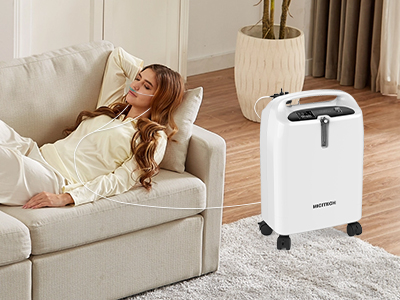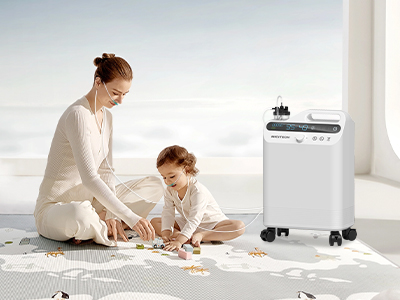19 May 2025
By day, breathlessness is blatant; by night, it skulks in the shadows. Nocturnal hypoxemia—dangerously low oxygen saturation during sleep—often goes unreported because the patient is, quite literally, unconscious. For millions, a discreet oxygen concentrator in the bedroom becomes the unsung hero, transforming fractured sleep into restorative slumber.

Physiology of Sleep and Oxygen Demand
Sleep is not a single state but a cycling ballet of NREM and REM stages. During rapid‑eye‑movement sleep, intercostal muscles slacken and breathing turns erratic. A healthy individual compensates effortlessly, yet patients with respiratory compromise cannot muster the extra effort. Blood oxygen dips, the heart races, and organs flirt with hypoxic injury. This repeated nightly assault accelerates cognitive decline, pulmonary hypertension, and arrhythmias.
Who Requires Oxygen During Sleep?
COPD & Overlap Syndrome – Those already struggling for breath while awake descend further into desaturation after lights‑out.
Obstructive Sleep Apnea & Obesity Hypoventilation – Airway collapse couples with inadequate ventilation; oxygen acts as a biochemical safety net.
High‑Altitude Residents & Cardiac Patients – Thin air or impaired circulation means less O₂ delivered per heartbeat; supplemental oxygen restores equilibrium.
Diagnostic Gold Standards
A one‑off daytime pulse oximeter reading tells only half the tale. Overnight oximetry logs saturation every second, unmasking stealthy drops. Polysomnography—the sleep lab grand slam—layers EEG, airflow, and capnography, quantifying apnea–hypopnea index (AHI) and cumulative time below 88%. Armed with these metrics, clinicians determine whether nocturnal oxygen is a luxury or a lifesaver.
Choosing the Right Oxygen Delivery System
For bedroom use, the stationary concentrator reigns—quiet hum, reliable flow, and zero tank refills. Travelers or studio‑apartment dwellers may favor compact portable units. Continuous‑flow settings bathe users in a steady stream, ideal for those with shallow breathing, whereas pulse‑dose units economize by sensing inhalation peaks. Add a whisper‑soft humidifier bottle to dodge nasal desertification.

Integrating Oxygen with CPAP or BiPAP
Many sleep apnea patients segue from single to dual‑modality therapy. Oxygen tubing splices into the PAP circuit via a simple bleed‑in connector. Flow must be calibrated so the final FiO₂ (fraction of inspired oxygen) meets prescription without blasting masks off. Vigilant leak checks, heated hoses, and chin straps keep the nocturnal contraption surprisingly comfortable.
Safety Protocols While You Slumber
Oxygen fans flames faster than gossip spreads. Ban candles, space heaters, and mid‑night cigarettes within ten feet of the concentrator. Route tubing behind the headboard to avoid nocturnal lasso scenarios. Finally, invest in an uninterruptible power supply; a thunderstorm should never pull the plug on your lungs.
Measuring Success and Adjusting Therapy
After a fortnight, repeat overnight oximetry. If mornings still greet you with lead‑brick headaches or soul‑crushing fatigue, flow rates need tweaking. Many modern concentrators offer Bluetooth telemonitoring, transmitting data to respiratory therapists who fine‑tune settings remotely. It’s personalized medicine wrapped in Wi‑Fi.
Quality‑of‑Life Enhancements
Restorative oxygenated sleep is an elixir. Patients report laser‑sharp morning focus, buoyant moods, and exercise tolerance once thought impossible. Cardiologists cheer as nocturnal hypoxia—an unheralded driver of hypertension and arrhythmia—recedes. In the words of one grateful user, “I no longer greet dawn like a zombie auditioning for a coffee commercial.”
Conclusion: Restorative Nights Through Oxygen Mastery
Nighttime oxygen therapy is both science and stewardship. When prescribed judiciously, it rescues organs, reboots energy, and rewrites prognosis curves. Responsibility falls on users to respect safety, on clinicians to titrate precisely, and on technology to keep innovating. Tomorrow’s horizon hints at AI‑directed concentrators that anticipate desaturations before they strike—ushering in an era where every sleeper breathes easy, dreams deep, and awakens empowered.
Keywords: oxygen therapy
Originally published 19 May 2025, updated 19 May 2025.